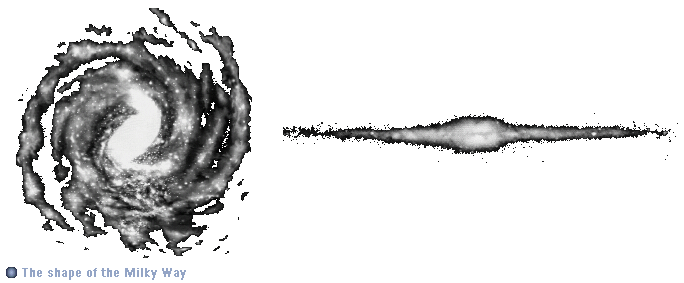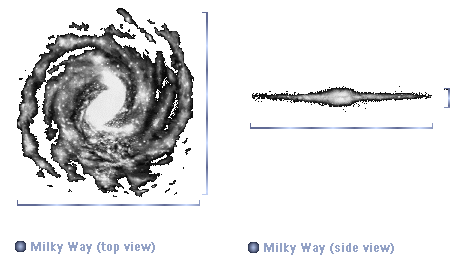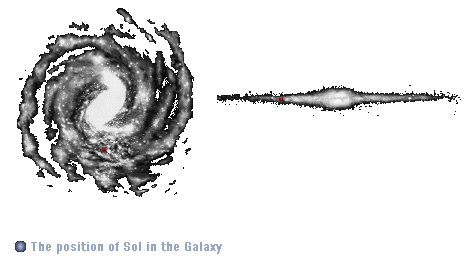
|
Our journey through the Star Trek universe starts in the real world, because the world of Star Trek is based on the reality, despite all fictious elements. All the adventures, the voyages through the totality of the universe and the unknown take place on the same playing ground, which we still have to get to know: our Galaxy or "the Milky Way". This galaxy is the smallest common denominator of Star Trek and the real world, since real life as well as the "fictious" lives in Star Trek begin, progress and finally cease here.
2.1.1 Shape and dimensions of the Milky Way

Although already in
the ancient, people could glance at the "street of milk" in clear, starry nights
on the Southern sky, it was not until the era of the renaissance that people turned away
from the mythology of a "street of the gods" and recognized its true meaning. In
the 17th century, Galileo Galilei recognized with his self-developed first astronomical
telescope that the legendary Milky Way is nothing other than an accumulation of countless
stars with different intensity. Unfortunately, Galileo's idea wasn't pursued and it was
not until the 18th century that William Herschel attained further knowledge on the shape
of our Galaxy. By his unique method of the "star calibration", which laid the
foundations for the stellar statistics, he could work out a model of the star distribution
and therefore the first real map of the Milky Way.
According to his "millstone model", the complicated system of millions of stars,
in which the Sun appears to be only a tiny, glimmering point of light, has the shape of a
flat disc; a description that is amazingly getting nearer the reality. However, he
considerably underestimated the dimensions of the Galaxy, whose diameter he fixed at only
9000 ly and whose thickness he fixed at 900 ly.
After numerous other, faulty theories and misinterpretations of the obtained data, which
lead, for example, to a huge galaxy of 300000 ly in diameter, in the twenties of the 20th
century, the scientists finally made considerably progress: Edwin Hubble identified the
innumerable "spiral nebulae" on the sky to be autonomous star systems
independent from our Galaxy, which people called "extragalactic nebulae" at that
time and which are today called "galaxies". With his classification of the
galaxies, the parameters for the further examination of the shape of our Galaxy were
fixed, because there were no reasons for the assumption that the Milky Way should take a
special position in shape and structure. 30 years later, several teams of scientists
finally could prove by the examination of the distribution of hydrogen within the Galaxy -
an elementary method for the exploration of the exact structure of star systems -, that
the Milky Way has a typical spiral shape as
well; according to Hubble's classification, it can be assigned to the galaxy type Sbc, what corresponds to a spiral galaxy with
medium-sized core and tightly till loosely winded arms.
| The diameter of the Galactic disk is almost exactly 100000 ly, although recent measurements have proven that in places, the Galaxy has a radius of more than 50000 ly. On average, the Milky Way has a thickness of 2000 ly, however, the "Galactic side view" reveals that the Galactic core in the center of the Galaxy, which has a diameter of about 3000 ly, has a thickness of up to 5000 ly. This part of the Milky Way is therefore also called "central bulge" or "Galactic core". |  |
Due to this enormous size - the spatial volume should be approximately 6.28x1013 ly3 - nearly all Star Trek episodes and movies are set in the Milky Way, and only rarely the Enterprise has left the Galaxy and ventured into the vastness of the universe, often by a scientific doubtful or not elaborated method. This isn't surprising if you consider how long it would take even the fastest Star Trek vessel to cross the Galaxy:
| Crossing the Galaxy in the Galactic plane (100000 ly) | ||||
| at warp 6 | at warp 8 | at warp 9 | at warp 9.6 | at warp 9.9 |
| 254 years | 98 years | 66 years | 52 years | 33 years |
Of course, nowadays the universe appears to be even bigger, because one million years would not be sufficient to reach the opposite side of the Milky Way by present means.
2.1.2 Structure of the Milky Way
If we look at the Milky Way "from outside" within the three-dimensional space, three main components can be clearly distinguished:
1. The thin Galactic disc consists of about 100 million young stars and stars of medium age, which are arranged along the spiral arms. The 5 most important arms are: the Orion or Local Arm, the Perseus Arm, the Sagittarius Arm, the Centaurus Arm and the Cygnus Arm. The Galactic arms revolve around the Galactic center, with the sun needing 225 Mio. years for one complete revolution around the core. The Galactic disc still contains numerous active star formation regions, which consists of the potential or actual predecessors of the stars: gaseous nebulas, globules and proto stars.
2. The galactic core has a much higher star density than the other parts of the Galaxy; therefore, it appears to be a homogenous white thing. In addition, the innermost 1500 ly of the Galaxy contain a huge reservoir of gas, which is more concentrated than in any other Galactic region and is enough to form 100 million further stars. A peculiar region in the entire Milky Way, called "the Arc", surrounds the innermost 100 ly of the core. "The Arc" is a gaseous strip formed by a strong magnetic field, which gaseous filaments resemble magnetic current tubes - therefore, it is nothing other than the real counterpart to the Galactic Barrier in the center of the Star Trek galaxy. Additionally, in the center of the core, there is a strong radio source, Sagittarius-A, which is supposed to be a Black Hole. In the Star Trek universe, the galactic center was only reached twice - 2287 and 2368.
3. The outmost region
of the Galactic disc which is not visible anymore is called the Galactic halo. The halo
does only contain about 1% of the stars in the Galaxy, which are very old and extremely
dim. furthermore, the spherical cloud of 200 star clusters which surround the Galaxy is a
part of the halo. Despite the low contribution of the halo to the Galactic star
population, it has a outstanding significance for the Galaxy, since it astonishingly
contains about 90% of the total mass of the star system. Hence, this mass must be caused
by some kind of not visible, inactive, non-radioactive matter - the so-called black
matter, whose existence could only be proven by the gravitation effect on the visible
matter.
In the Star Trek universe, the Galactic halo was, for example, explored in 2357 by the
Arias expedition, whose goal it was to examine massive, compact halo objects.
Additionally, the Star Trek galaxy has a mysterious spherical energy field within the halo
- called the Great Barrier, which couldn't be detected in the real Milky Way up to now.
2.1.3 The sun within the Milky Way
 |
Within the Galaxy, our sun is only a tiny point in the totality that gets lost in the light of 100 billion similiar points. The interstellar space is taken up by gas atoms and large dust clouds, which impair our view to the innermost parts of the Galaxy. Hence, it was correspondingly difficult to determine our position in the Galaxy exactly, that means our situation relative to the only fixed point within our rotating star system - the Galactic center. |
While in the first Galactic models,
people believed in a heliocentric situation with the Sun in the center, and also
Hubble's "millstone model" placed the Sun near to the center, in the 19th
century the view as accepted that the Sun must be relatively far away from the Galactic
core. By radiometric and infrared measurements, 100 years later this distance could be fixed
to 8 kpc - or about 30000 ly, with the Sun being located in the Local / Orion Arm. After numerous other, far more precise
measuring, today scientists believe with relative certainty that the real distance is
shorter, about 24000 ly.
At least in terms of the vertical position of the Sun in the Milky Way, we can assume a
heliocentric situation - the Sun is located only about 50 ly above the Galactic plane - the symmetrical
place which vertically divides the Milky Way in two dish-shaped components.
Because our star system revolves around its center, the position of Earth in the Milky Way
can be every point of a circle with a radius of 12000 ly - in most graphic depictions,
however, it is located exactly in the middle of the lower half of the Galaxy.
Our little tour through the Milky Way already ends, because it is well known that we're still exploring our solar system and can only dream of the voyages to all those faint stars on the sky - or we watch Star Trek and have a glance at the possible future of mankind, by venturing into the vast totality known as the universe.
� 1999-2001 by Star Trek Dimension / Webmaster. Last update: April 27th, 2000